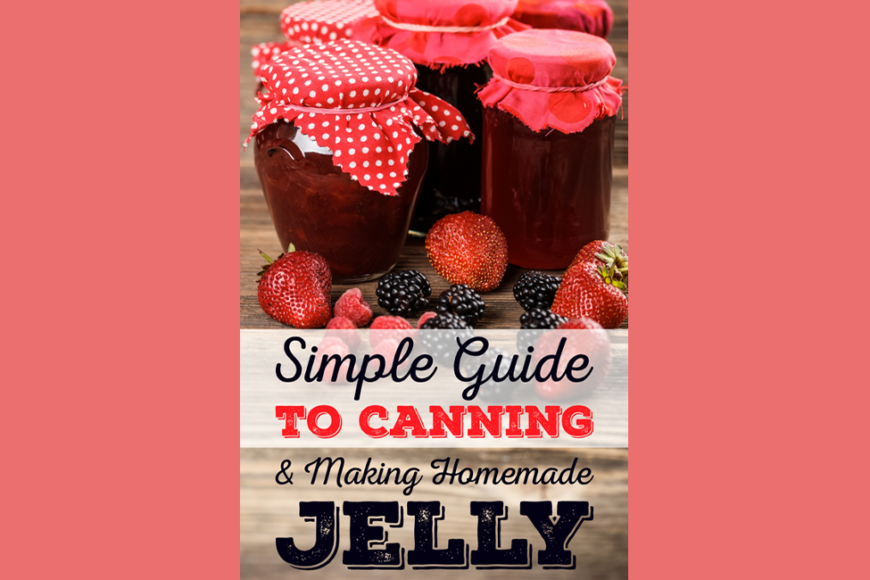
Simple Guide to Canning – Part 2: Terminology and Supplies
The following is a guest post by Raising A Family On A Budget.
If you have been seriously considering canning, you probably have poked around a few websites and maybe even checked out a book or two from the library. And if you are like some people, reading through these books brings flashbacks of high school chemistry class with lengthy procedures, tons of equipment, unfamiliar terms, and a heavy dose of caution.
While canning is a science, and you do have to follow certain steps in order to have a final product that is both delicious and safe to consume, it does not have to be overwhelming.
Before we get started, let’s review some of the terminology that you will come across in canning.
- Canning Jars – also known as Mason, Ball or Kerr Jars. A glass jar with a 2 piece lid. When you first buy the jars, they come with the caps and rings
- Cap – the part of the lid that seals directly to the jar. These can only be used once.
- Ring – the part of the lid that holds the cap to the jar.
- Pectin – a natural jelling agent added during the cooking process to guarantee that fruit spread sets up as desired.
- Canning Kettle – A large heavy bottom pot that you can place your filled jars in with 2 inches of water above the top of the lids
- Water Bath Canner – the usual canning method for preserving jams, jellies, pickles, and most sauces.
- Head Space – the amount of space you leave in the top of the jar; this varies by recipe.
- Processing Time – the amount of time the filled jars need to be in the canning kettle once the water has returned to a boil.
I find that a large soup pot works well as a canning kettle, and do not see the point to purchasing a special canning kettle. If you have a tall stock pot or crab pot this will work nicely for processing pint jars, and smaller jars. If you want to process quart jars, you may need to purchase a separate canning kettle (which is why most of what I make is in 8 oz or pint jars).
The next tools of the trade are a jar lifter and a funnel. You can often purchase these as part of a canning kit. The jar lifter is exactly that, a set of tongs designed to lift jars out of the canning kettle without sacrificing your fingers. The funnels for canning are a must! They fit nicely inside the standard and wide mouthed jars, and are a great way to ladle hot jams into the jars while keeping the lip of the jar clean.
Next up is pectin. If you are planning on making any variety of fruit spread, you will want to buy a commercially produced pectin such as Ball Pectin or SureGel. There are liquid and powdered pectins available on the market, and the choice in variety is yours. I prefer powdered pectins for jams, but tend to use liquid pectins for jellies and butters. Its just what my recipes call for so that is what I do, but the choice is completely yours. In addition, there are pectins available that use little or no sugar. These are a good option if you are preparing a fruit spread for someone who is diabetic and can’t have the added sugar, but the quality of the finished product is different than with a pectin and sugar combination.
Now it is time to pick your jars. Ball and Kerr now make a variety of designer jars, as well as the plain standard jars. If you are making the jams as a gift, by all means purchase the pretty jars. If the items are just for you and your family, I say go with the plain jars and save yourself a few dollars.
When it comes to jars, I am a little particular about what sizes I use for which items, but again, the choice is up to you.
- 4 oz jars – these are great for just a sampling of the jam. I like to have these on hand for when there is a little jam left in the pot that won’t fill a larger jar. These are also nice if you are giving jam as a gift and want to give the recipient a variety.
- 8 or 12 oz jars – these are ideal for jams and other fruit spreads.
- Wide Mouth 8 oz jars – these are perfect for salsa. They are short and wide which is perfect for dipping right from the jar.
- Pint Jars – this is the jar that I use the most at home. It is perfect for pickles, jams, apple sauce, barbecue sauce, and marinara.
- Quart Jars – I don’t recommend making jam in quart jars, but they work well for anything else as long as you have a canning kettle that is tall enough to accommodate the jars.
For the purpose of this series, we will be working with 8 oz jars.
I have found that the best prices on canning supplies are at Walmart. They tend to have a large selection in their stores, but their canning supplies are only available from May through August in our area (you may be lucky to have a longer growing season where you live, and in turn Walmart may carry things later into the fall).
If you don’t have a Walmart in your area, many grocery stores also carry canning supplies, however they tend to be more expensive. You can also find a lot of the basic supplies at your local hardware store (TruValue, Ace, Agway or privately owned establishment). You can also purchase canning supplies from Amazon.
Other posts in this series:
- Simple Guide to Canning and Making Homemade Jelly – Part 1: Introduction to Canning
- Simple Guide to Canning and Making Homemade Jelly – Part 3: Step-by-Step Canning Directions
- Simple Guide to Canning and Making Homemade Jelly – Part 4: Fruit and Pectin
Stephanie Huston is the mom behind Raising A Family On A Budget. Her main focus is saving families money through couponing and shopping sales for the items we need and would buy anyway. In addition, there are often ideas shared for other frugal aspects of our lives (cooking, dining out, DIY, vacation, etc).
This post contains affiliate links, which help support this site at no extra cost to you. Please read our disclosure policy here.




4 Comments
Cynthia
I can alot for my family as well there is nothing like the taste of canned peaches in the winter time. I purchased all my canning supplies at garage sales except for my pressure cooker – I did buy that new. I even got my Ball Blue Book at a garage sale. What I cannot grow I buy at a veggie auction and split with a friend. We have 2 actions sites in our area less than 45 minutes away. I can peaches, pears, tomatoes, salsa, green beans, carrots, corn, cherries, apple pie filling.
We freeze corn, blueberries, raspberries, strawberries and dry onions too. We are very blessed in this country to have such abundance!
Stephanie
That’s great!! I would love to start canning that much! It would be great to have all that in the winter!
Tanya
Canning is not just for Jellys or Jams. I can everything I grow in the garden: pickles, banana peppers, tomatoes, gardenaro, salsa, spaghetti, chili, beans, mushrooms…etc. It is not hard and I have found the best way to get started is to purchase all the necessary materials you stated above and a canning book (I have one made by Ball). If you are new to canning there are packet you can use to help you get a good start – Mrs. Wags and Ball have the best seasoning.
Stephanie
I love the Mrs. Wages seasonings! We’ve tried both the pickle and salsa seasonings and both are great!